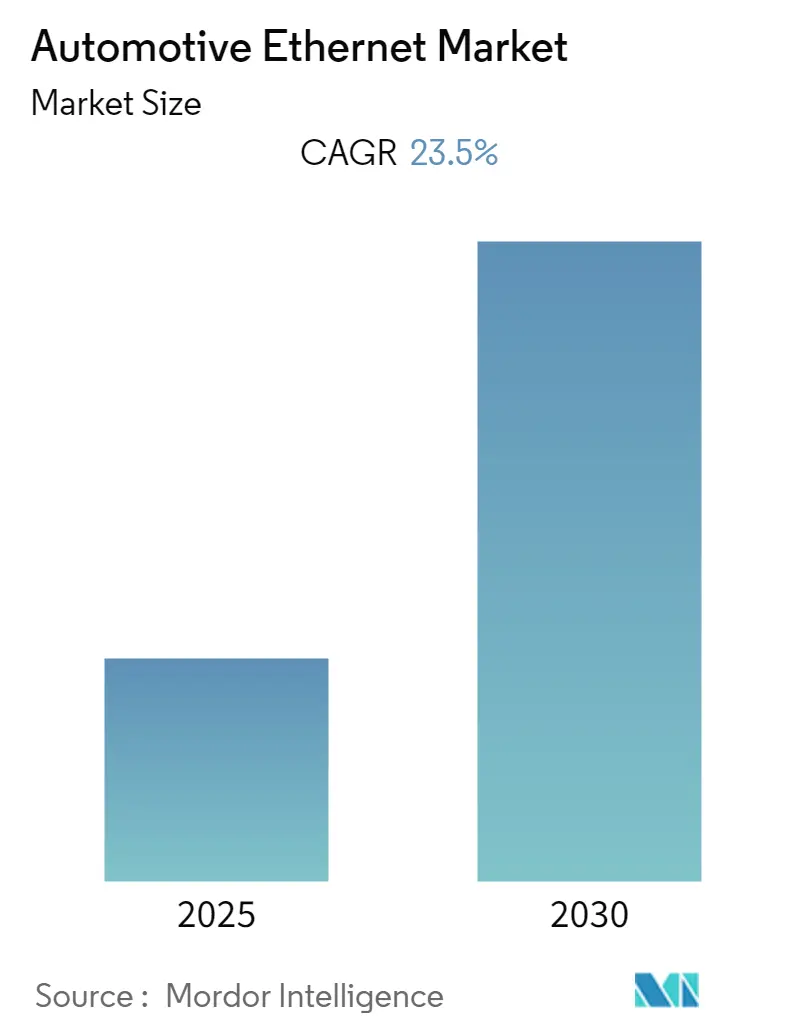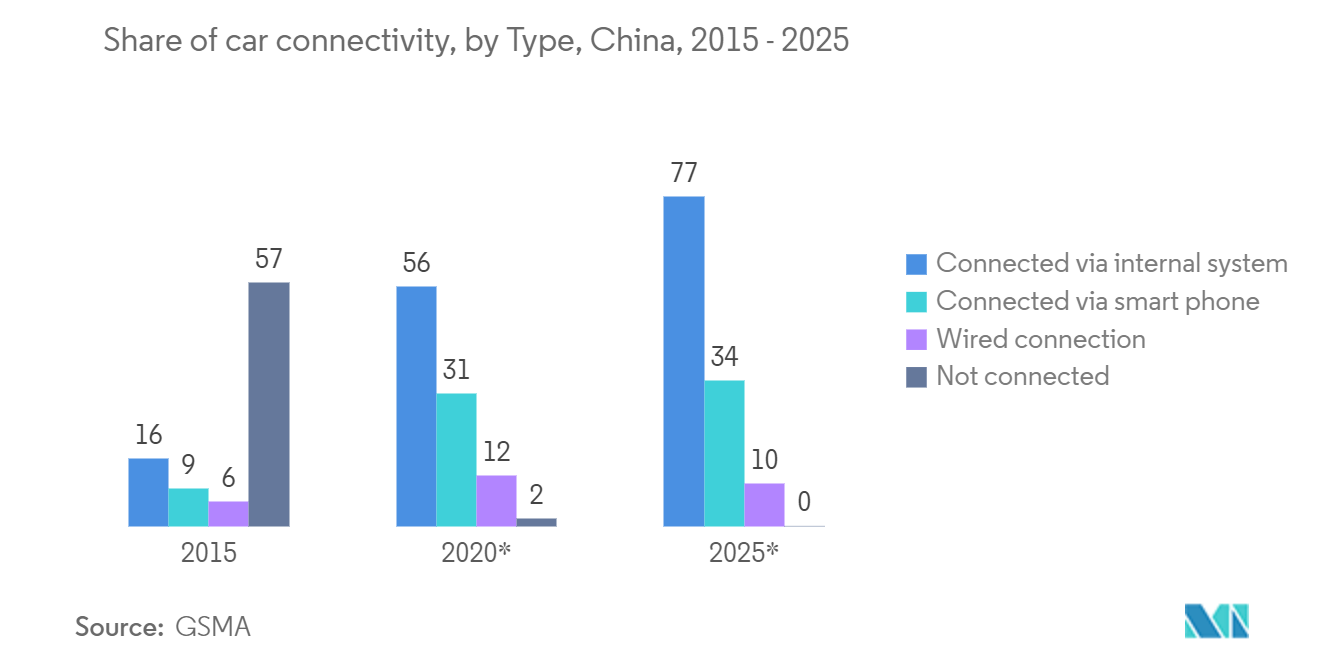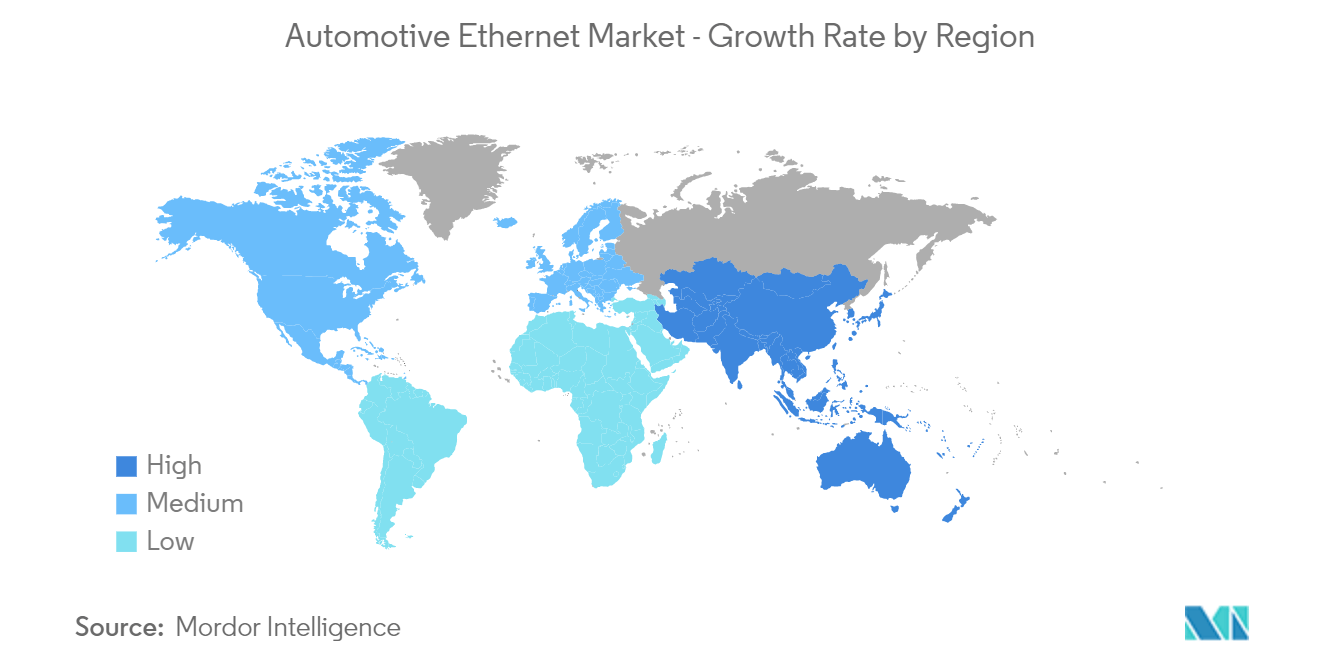Automotive Ethernet Market Analysis
The Automotive Ethernet Market is expected to register a CAGR of 23.5% during the forecast period.
- The increased deployment of Advanced Driver Assistant System (ADAS), infotainment, rapid progress in the development of autonomous vehicles, and the low cost of ethernet has led to the immense growth of automotive ethernet as it serves the purpose of connecting in-vehicle electronic system efficiently as compared to traditional harness.
- Automotive ethernet offers connectivity across automotive applications, such as powertrain, chassis, body and comfort, ADAS, and infotainment systems. Supporting high bandwidth applications operating at high or low speed addresses the challenges designers and engineers face in integrating different systems.
- Ethernet tends to bypass traditional cabling for connectivity, allowing all vehicle components to connect with lighter and more effective wires. This alone has enabled manufacturers to reduce connectivity costs by 80% and cabling weight by 30%. This also serves as a potential application for the cost-effective development of a connected car.
- High-performance navigation systems, high-end entertainment, and telematics require the system to remain 'always on' in a connected car. The increasing bandwidth for in-vehicle data communications has driven the ethernet deployment market.
- With the recent outbreak of COVID-19, the automotive ethernet market is witnessing a decline in growth in the short run due to major automotive manufacturing plants having stopped their production in response to the lockdown being enforced by many countries across the world.
Automotive Ethernet Market Trends
Increased Demand for Advanced Driver Assistance System (ADAS) to boost the Market Growth
- It has been estimated that as the number of vehicles equipped with autonomous driving increases, automotive ethernet is expected to witness increased opportunities for growth. Autonomous driving heavily depends on HD maps with road-based information like lane sizes, crosswalks, and road signs. HD maps are built with data collected from sensors. Ethernet is needed to connect these components to maintain efficient data transfer and, therefore, will contribute to the growth of automotive ethernet.
- Currently, in the automotive sector, the introduction of MEMS associated with ADAS, the emergence of connected vehicles, and the technological advancements of infotainment and IoT equipment is leading to an increase in electronic control unit contents in automobiles. The growing adoption of IoT solutions in automotive provides growth opportunities to a wide range of highly connected modern ADAS and autonomous driving functions. Having vehicles connected to everything in their vicinity or Vehicle-to-Everything (V2X) is an essential step toward a connected network of autonomous vehicles. Ethernet compatibility advantages when connecting vehicles to smart infrastructure make it an essential vehicle part.
- According to the International Organization of Motor Vehicle Manufacturers (OICA), approximately 80 million vehicles were produced globally last year. With growing volumes of vehicles and the rising demand for safety features designed to avoid collisions and accidents, companies are offering technologies that alert the driver about potential problems. Many vehicle manufacturers highly adopt ADAS to provide customers with Emergency Brake Assist, Adaptive Cruise Control, Blind Spot Detection, Rear Cross-Traffic Alert, Traffic Sign Assist, Intelligent Lights, Intelligent Speed Assist, and Lane/Road Departure Alert.
- Government regulations revolving around safety and security are also major drivers for the growth of automotive ethernet. While many of these systems are embedded in current models of cars, some of them will become mandatory as they contribute towards road safety. For instance, in March 2019, the European Commission announced a new rule to make Intelligent Speed Assistance (ISA) mandatory for all newly manufactured light vehicles starting in the last year. Euro NCAP and the US NHTSA safety assessment are additional driving forces behind ADAS adoption, which include the availability and the performance of safety assistant systems in their ratings.
Asia-Pacific to Witness Significant Growth
- Increased production of passenger vehicles is one of the major factors driving the market growth in the Asian-Pacific Region. Automakers like Mercedes-Benz, Ford, and Volkswagen are rolling out expansion plans in India to maximize manufacturing capacity and output and minimize the local market's supply-demand gap. With these plans, the Indian market for time-sensitive in-vehicle networking components will increase. Thus the automotive ethernet market is poised for strong growth through the studied period.
- With more original equipment manufacturers (OEMs) providing new connected car capabilities with each new model produced, the connected car market in India is seeing significant advancements. The market for vehicles with enhanced HMI features, more connected technologies, and the integration of advanced driver assistance system (ADAS) solutions has grown in response to rising consumer demands for comfort, convenience, safety, and security.
- Except for the base variation, most premium OEMs in India now include smartphone connectivity or embedded connectivity as a standard feature. In contrast, volume OEMs only include smartphones or embedded connectivity on mid- and high-end variants. The development of connected automobiles in the Indian market has been facilitated by consumers' growing awareness of connected car services and willingness to pay for pricier options.
- Faster GDP growth and highly aspirational Asian consumers are the two major growth drivers for most regions, such as China, India, Malaysia, and the other developing markets in Southeast Asia in the coming years. In terms of consumption of connected and autonomous vehicles, North America and Europe remain the prominent regions owing to the presence of significant players such as Marvell Technology Group Ltd and Broadcom Incorporated, among others, the high acceptance rate of advanced technology and increasing adoption of Ethernet in-vehicle networks for mainstream models.
- However, closure trends in India led the SIAM to estimate that nearly USD 280 Million per day was revenue loss for Indian automakers and component manufacturers amidst the pandemic. Significant players like Maruti Suzuki India, Hyundai, Honda, Mahindra, Toyota Kirloskar Motor, Tata Motors, Kia Motors, and MG Motor India have temporarily shut down their plants. The market is very likely to suffer from potential component supply chain disruption, leading to reduced sales and production of an automotive ethernet.
Automotive Ethernet Industry Overview
The automotive ethernet market is fragmented in nature due to high competition. Despite the fragmentation, the market is primarily tied by the regulatory requirements for establishment and operation. Furthermore, with increasing innovation, acquisitions, and partnerships, market rivalry tends to rise in the future. Some major market players are Broadcom Inc., NXP Semiconductors NV, Marvell Technology Group Ltd, Microchip Technology Inc., and Texas Instruments Inc.
- May 2022 - The BCM8958X, a high bandwidth monolithic automotive Ethernet switch device from Broadcom Inc., was delivered. It was created to meet the expanding bandwidth need for in-vehicle networking applications and to promote the adoption of software-defined vehicles (SDV). With its 16 Ethernet ports, up to six of which are 10 Gbps capable, integrated 1000BASE-T1 and 100BASE-T1 PHYs, and higher switching capacity, the BCM8958X offers the increased flexibility and central compute ECU architecture support needed for automotive zonal electronic control unit (ECU) architectures. This switch also has a cutting-edge rule-based packet filter engine that can adjust to various vehicle operation modes to improve driving security.
Automotive Ethernet Market Leaders
-
Broadcom Inc.
-
NXP Semiconductors NV
-
Marvell Technology Group Ltd.
-
Microchip Technology Inc.
-
Texas Instruments Inc.
- *Disclaimer: Major Players sorted in no particular order
Automotive Ethernet Market News
- May 2022 - In order to enable high reliability for mission-critical applications that could support vehicle safety and performance, Marvell unveiled its third generation Marvell Brightlane Ethernet Switch, the industry's most sophisticated automotive securely managed switch and the first with lockstep dual-core Arm processing redundancy. The new automobile switch comes with more advanced networking and security features, as well as more bandwidth and ports compared to the previous generation. It serves as the primary digital framework for next-generation Ethernet-based zonal designs.
- January 2022 - Toshiba Electronics Europe GmbH launched a new Ethernet bridge IC - the TC9563XBG. It is intended for automotive zonal architecture, infotainment, telematics or gateways, and industrial equipment. Two 10 Gbps Ethernet Media Access Controller (MAC) supporting a variety of interfaces, including USXGMII, XFI, SGMII, and RGMII, are built into the new bridge IC. Both ports enable low-latency IEEE802.1 time-sensitive networking (TSN) for synchronous processing and Ethernet IEEE802.1 audio/video bridging (AVB) for real-time processing. The ports additionally allow "simple" single root I/O virtualization (SR-IOV) on PCIe devices.
Automotive Ethernet Industry Segmentation
Automotive ethernet is a physical network used to connect various components in a vehicle with the help of a wired network. It is designed to meet electrical and bandwidth requirements. This arrangement reduces the cost of cabling and labor required by attaining synchronization, thereby reducing the network's complexity within the vehicle. The report provides a detailed analysis of the components used in various vehicle types and a detailed regional analysis. Moreover, the qualitative trends for the bandwidth, such as 10Mbps, 100Mbps, 1Gbps & beyond, and application-related trends related to ADAS, infotainment, powertrains, chassis, etc., are incorporated in regional analysis.
The automotive ethernet market is segmented by components (hardware, software, and services) and geography (North America, Europe, Asia Pacific, Latin America, and Middle East & Africa).
The market sizes and forecasts are provided in terms of value (USD million) for all the above segments.
| By Component | Hardware |
| Software and Services | |
| Geography | North America |
| Europe | |
| Asia-Pacific | |
| Latin America | |
| Middle East and Africa |
Automotive Ethernet Market Research FAQs
What is the current Automotive Ethernet Market size?
The Automotive Ethernet Market is projected to register a CAGR of 23.5% during the forecast period (2025-2030)
Who are the key players in Automotive Ethernet Market?
Broadcom Inc., NXP Semiconductors NV, Marvell Technology Group Ltd., Microchip Technology Inc. and Texas Instruments Inc. are the major companies operating in the Automotive Ethernet Market.
Which is the fastest growing region in Automotive Ethernet Market?
North America is estimated to grow at the highest CAGR over the forecast period (2025-2030).
Which region has the biggest share in Automotive Ethernet Market?
In 2025, the North America accounts for the largest market share in Automotive Ethernet Market.
What years does this Automotive Ethernet Market cover?
The report covers the Automotive Ethernet Market historical market size for years: 2019, 2020, 2021, 2022, 2023 and 2024. The report also forecasts the Automotive Ethernet Market size for years: 2025, 2026, 2027, 2028, 2029 and 2030.
Our Best Selling Reports
Automotive Ethernet Industry Report
Statistics for the 2025 Automotive Ethernet market share, size and revenue growth rate, created by Mordor Intelligence™ Industry Reports. Automotive Ethernet analysis includes a market forecast outlook for 2025 to 2030 and historical overview. Get a sample of this industry analysis as a free report PDF download.







